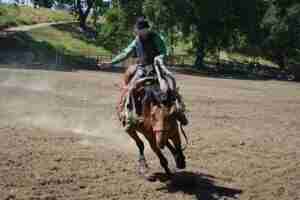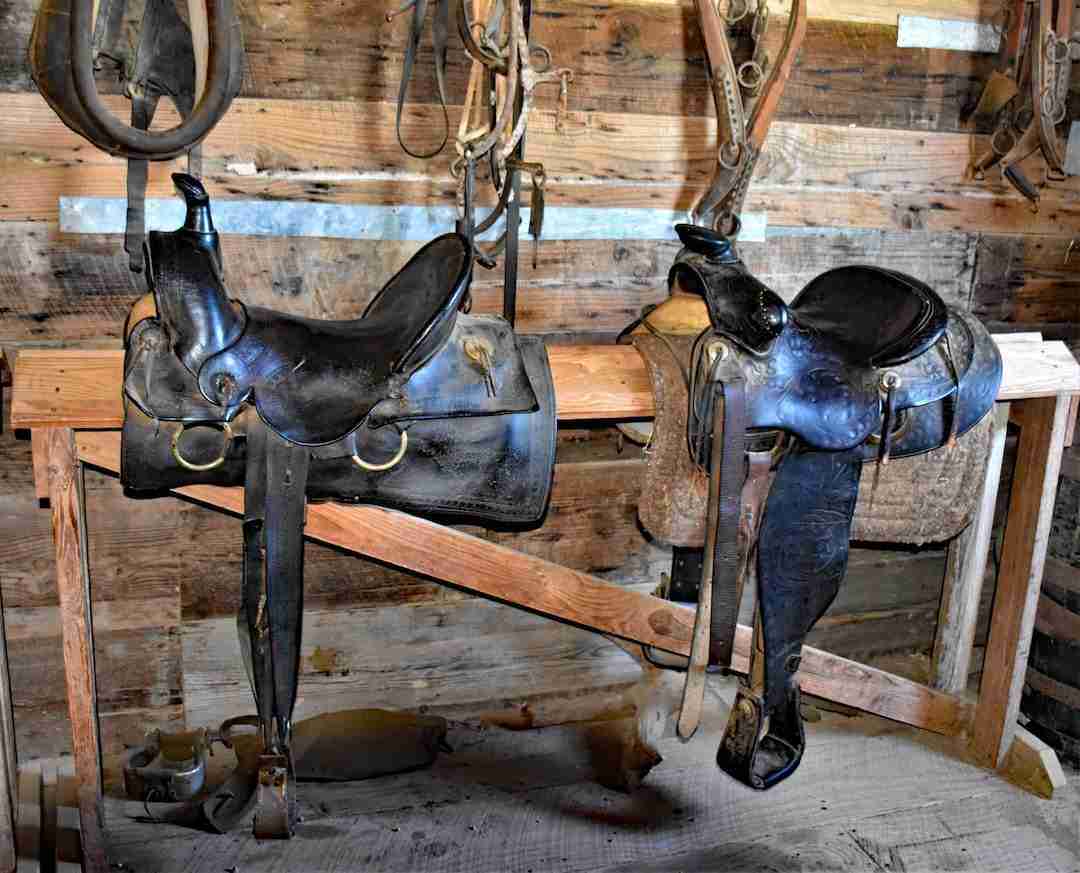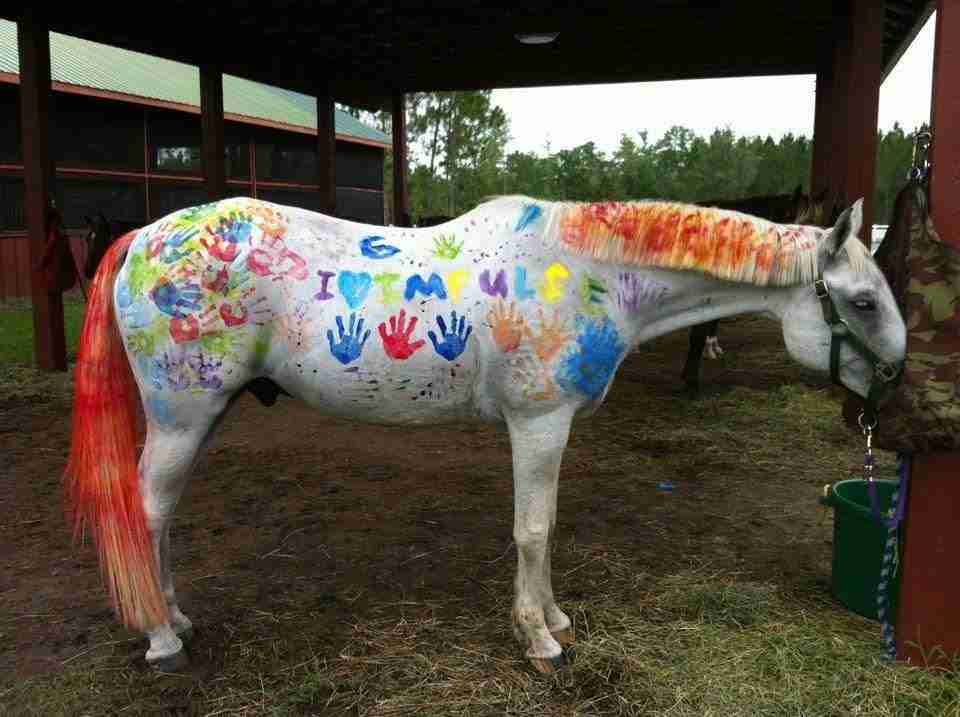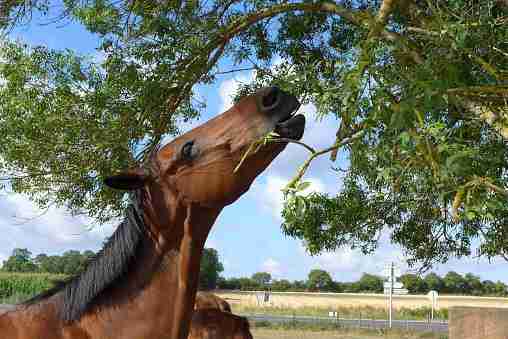Many people wonder how many miles can a horse run in a day. A definite answer is difficult as it’s dependent on so many factors. Age, health, overall fitness, breed, and stamina of the horse are some of them. Others include the weather, terrain conditions, and what type of gait your horse is employing throughout the journey.
When walking at a leisurely pace, a healthy horse can manage 20 to 35 miles a day without rest and up to 50 miles a day when stopping to rest along the way. A fit trail horse can manage 50 miles a day, whereas an elite endurance horse can run 100 miles in a single day with regular rest breaks.
Before we had cars, we relied on horses to get us from A to Z. Back then, horse owners looked after their horses with lots of attention to detail regarding fitness training, nutrition, and overall maintenance to keep them functioning at optimal levels. Generally speaking, horses of old could do more mileage than today’s horses because they had to.
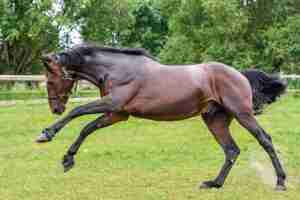 How Many Miles Can A Horse Cover In A Day?
How Many Miles Can A Horse Cover In A Day?
Horses are powerful animals capable of walking, trotting, cantering, and running for many miles per day when fit and healthy.
An average healthy horse should have no problem traveling 20 to 35 miles daily. With rest and water breaks, the average horse can push close to 50 miles when walking most of the way.
A trail-conditioned horse (a horse kept trail-fit by regularly being taken out on one) can do 50 miles per day.
An elite, well-trained endurance horse can run 100 miles in a day, as proven by horses that finish 100-mile endurance races in 24 hours.
The per-day mileage mentioned above will often have to go hand in hand with regular rest stops along the way, where food, drink, and rest is provided to the equine.
 The Horse’s Gait Affects Mileage Per Day
The Horse’s Gait Affects Mileage Per Day
Horses possess different gaits and use them separately depending on the situation. When a horse senses danger, it will gallop away at full speed.
The faster the horse moves, the faster it will get fatigued and the longer the required rest periods.
When encouraged to cover long distances, a steady walking gait, combined with a trot, canter, and occasional gallop, can be used to get the most out of the horse without affecting the equine’s health.
| Type of Gait | Average Speed of Gait | Average Distance Covered by Gait |
|
|
|
|
|
|
|
|
|
|
|
|
The slowest gait is the walk which doesn’t cover as much ground as the other gaits. The upside of the walking gait is that it puts the least strain on your horse, which means fewer breaks for food, water, and rest.
A horse using the walking gait can comfortably complete 35 miles without rest, and 50 miles per day, in a 12-hour session. The trot is a very useful gait when covering a large distance and can be employed for up to 10 miles before stopping for a rest.
The canter is a more comfortable ride for both rider and horse but tires the horse more quickly than a trot or walk. When you need to speed things up, a canter can be the ideal gait for up to 5 miles at a time.
A galloping horse will cover a distance of 1 to 2.5 miles before fatigue sets in. After a gallop, a horse will require some recovery time. Too much galloping during a journey will drain your horse’s energy and affect stamina levels.
To cover 100 miles a day, you must be an experienced rider paired with an energetic, well-trained horse. By using all of the gaits throughout the journey, and knowing when to stop for a rest and refreshment, covering 100 miles in a single day is possible.
How Many Miles Can An Endurance Horse Run In A Day?
Endurance riding is when a horse and a rider enter a trail competition with different lengths of trail riding, such as 25, 35, 50, 75, and 100-mile races or longer 155-mile multi-day races. Multi-day endurance races have specific mileage limits which need to be reached for each racing day.
To give you an idea of the miles horses can complete in single or multiple days, we only have to look at American Endurance Ride Conference (AERC) sanctioned events to give you a proper idea of the mileage capabilities of our four-legged friends.
The endurance race distance that is most common is 50 miles and features a completion time limit of 12 hours. Race distances of 75 and 100 miles are also on the calendar, and these longer races typically have a time limit of 24 hours.
The most famous 100-mile races in North America are the Tevis Cup (The Western States Trail Ride), held during July in California, and the Old Dominion Ride held annually in Virginia.
The 2022 Tevis Cup was won by a 13-year-old Arabian gelding called L.C.C. Pyros Choice. The Haggin Cup was awarded the day after the Tevis Cup to one of the Top 10 horses in the best physical condition. It was presented to another 13-year-old Arabian gelding nicknamed “Ozzy.”
Some events are a 100-mile race, split into two days of riding, where the horse and rider need to complete 50 miles per day. The AERC also allows beginner horses and their riders to enter smaller races via a Limited Distance division with race options such as 25- and 35-mile options.
The aim of endurance riding is to explore long scenic trails, keeping your horse healthy by walking, trotting, cantering, and galloping your way to the finish line.
Regular vet checks are mandatory along the course and found at designated rest stations. A horse can only continue the race when passing certain health checks, including dehydration, respiratory, pulse, and heart rate tests.
Horses must rest between 40-60 minutes after being vet checked, giving the rider a chance to feed and water the horse. Horses that show signs of heavy fatigue and lameness will be pulled from the contest.
When attempting long distances with your horse, it’s vitally important that you are good at controlling the pace, can see signs of any health issues, and know when to rest and feed your equine. You might cause serious harm when pushing your horse’s physical limits without proper management.
Endurance horses follow a strict exercise regime paired with a healthy diet and enough rest periods, ensuring they’re at a certain fitness level before attempting a grueling endurance race.
 100-Mile Record By A Horse
100-Mile Record By A Horse
Not only do we know that a horse can run 100 miles in a day, but we also know that some horses can do it faster than others.
The record for the fastest 100 miles by a horse and rider is held by Yousuf Ahmad al Beloushi with his grey gelding, Jayhal Shazal, with an incredible time of 5:45:44. The duo’s average speed was 17 mph.
The 100-mile record by a human is held by Zach Bitter, with a time of 11:47:21.
The Longest Multi-Horse Endurance Race Covers 621 Miles
World conqueror Genghis Khan introduced Mongolia’s first horse postal system in 1224. By setting up horse stations along Kharkhorin to the Caspian Sea, he could relay important messages in a matter of days.
Today, the Mongol Derby follows the route used by Genghis Khan’s messengers. The Mongol Derby is a 621-mile (1,000 km) race across the Mongolian grassland plains called the Mongolian steppe.
Riders who enter the “longest horse race in the world” have access to a team of Mongolian horses to help them complete the grueling race.
These terrain-hardened tough-as-nails equines can comfortably complete 24.9 miles (40 km) stretches across the open steppe, wooded mountain passes, semi-arid dunes, hills, crossings, and valleys. These Mongolian horses maintain a fast pace throughout the race.
The Mongolian horses provided are a mix between working horses and racehorses which maintains a fast pace throughout the race and will put many a Thoroughbred to shame. Participating horses are vet-checked, trained for the race, and healthy.
Factors That Limit A Horse’s Mileage Per Day
Weather and terrain conditions will also greatly impact how many miles a horse can travel in a day, as wet and muddy or rocky underfoot conditions will slow a horse down considerably.
Challenging terrain conditions such as deserts, rolling hills, canyons, and mountain forests will sap the energy out of a horse, as will a scorching sun. Horses do best in temperatures between 40-50°F.
A horse that’s been previously injured can also struggle to cover many miles a day, even when the injury has healed. Injuries that affect a horse’s gait, such as tendons and bone-related problems, can limit the number of miles a horse can do pain-free during a day.
How To Get Your Horse To Run More Miles Per Day
Horses are a bit like us humans. The more they practice something, the better they get at it. If you need your horse to be able to put out more miles per day, then you have to condition him to do it with a dedicated training program, a nutrition plan, and rest days spaced in between.
The breed does play a part in what you can expect endurance-wise from a horse, but it’s not the determining factor of whether or not you’re sitting with an endurance race winner. The age, overall health, fitness and stamina level, and injury history all play a part in the overall mileage that a horse can manage in a day.
A Well-Trained Horse Can Run More Miles Per Day
Your horse can clock more miles per day when it’s fit and healthy. Regular exercise, a nutritional diet, and ample rest periods will ensure that your horse can put a few extra miles on the clock.
A well-looked-after and healthy horse should have no problem clocking 20-35 miles per day (at a slow pace). Once off, with no activity the following day, a fit horse can cover 50 miles per day but will struggle the next day if not trained for successive days of traveling.
When dealing with an overweight or unfit horse, you must start the training process at an easy and doable pace. A typical way to start getting your horse to fitness is a 40-minute trotting session a couple of times a week.
After a couple of weeks, you can up the ante by doing a 5-mile workout session for 5 days of the week. The pace should be slow initially, and a slow progression of mileage and speed should be adhered to.
Speed training is also essential in conditioning an endurance horse. Interval speed training will improve the horse’s endurance. When getting your horse into shape, you must work on all facets of running (including sprint training).
If you start working out the unfit horse too hard initially, you may well end up injuring the horse. After 2 to 3 months, enter an endurance event to see where your horse is at regarding fitness levels.
The key to a horse managing many miles a day is overall fitness and health levels. When we humans don’t exercise constantly, we become unfit and unhealthy in a blink of an eye, especially when following a dodgy diet coupled with little sleep.
Horses are the same. We need to look after them if we expect them to be able to perform daily. Following a professional training program is advised when you’re looking to get the maximum mileage out of your horse.
Horse Breeds That Run The Most Miles In A Day
Certain horse breeds make excellent racehorses, such as the Quarter Horse, Akhal Teke, Andalusian, Appaloosa, and Thoroughbred.
When you’re looking for a horse breed that does well regarding endurance, breeds that can be conditioned to run lots of miles a day, then the following breeds should be your first options:
Arabian Horse
The king of the desert, the Arabian Horse, is a machine when it comes to endurance riding and has evolved in a way that makes them very capable of covering long distances in the desert or in more horse-friendly conditions.
Arabians are considered small (14.2 to 15.1 hands), yet they are fitted with large lungs and nostrils to take in more oxygen. Arabians require less food and water compared to other breeds and are predominately black skin protects them against sunburn.
Arabians are known as the best endurance breed around due to their light and compact frames, putting less stress on their joints and tendons.
Since the first World Championship was held in the U.A.E. in 1998, Arabian Horses has dominated the endurance scene, which features over 350 competitions each year.
Anglo-Arabian
To get the best of both worlds, regarding strength and stamina, the Arabian Horse is often crossed with a Thoroughbred to form Anglo-Americans.
Mustang
The iconic “wild horse” of the Wild West, the Mustang is a breed that evolved into a powerful equine species through survival of the fittest lineage. All the Mustangs, including the Kiger, Pryor Mountain, and Spanish Mustang, are known to have excellent stamina and endurance.
Conclusion
Not all horses are capable of running many miles a day. Some are built differently and can do loads of miles on the trot. The average horse, that’s relatively fit and healthy, will give you between 20-35 miles at a steady pace, no questions asked.
A horse used for trail walking and running can squeeze out 50 miles when you allow rest periods for water and food breaks. An endurance horse that’s properly conditioned and well-trained in the art of endurance running can run 100 miles a day or close to this figure.
Resources
https://www.fei.org/endurance/events/
https://www.ncbi.nlm.nih.gov/pmc/articles/PMC3196017/
https://www.thesprucepets.com/an-introduction-to-endurance-riding-1886877
https://www.thesprucepets.com/meet-the-arabian-horse-1886131
https://www.quora.com/How-far-can-a-horse-run-in-a-day
https://en.wikipedia.org/wiki/Mongol_Derby
http://www.olddominionrides.org/
https://www.dvm360.com/view/endurance-and-flat-racing-techniques-meld
https://www.usef.org/compete/disciplines/endurance/world-endurance-championship-2
https://en.wikipedia.org/wiki/Horse_gait
https://petkeen.com/how-far-horse-can-travel-in-a-day/
http://www.thelongridersguild.com/historical%20members/Historical_D.htm


